Daphne Palasi Andreades’s novel is a love letter to a home left behind

Courtesy of the Weissman School Of Arts And Sciences
February 13, 2023
The novel “Brown Girls” is not a story about a fictional character who goes off on fascinating adventures. It is not about a historical figure whose life we have the privilege of reliving in a way-too-long novel.
This is a story about brown girls. Girls who grew up in the dregs of Queens, hoping that they would get to leave someday; that they would become successful and never have to look back.
The novel is a retelling of author Daphne Palasi Andreades and her peers’ lives as brown girls growing up in Queens. The novel follows the girls as they move through each phase of life. Andreades spent her college years at Baruch College, graduating in 2015. Andreades made her alma mater proud when “Brown Girls” made it onto The New York Times’ list of recommended books for January 2022.
Some might find the idea for a plot a bit boring. Who would want to follow a bunch of girls around through their lives if there’s no action to keep the reader hooked?
But Andreades doesn’t disappoint. In fact, some of the more interesting parts of the novel come from the way it’s styled rather than the content itself.
“Brown Girls” takes a poetic approach over the course of the novel. Many of the chapters are kept short with only one to two pages.
A lot of repetition is shown throughout the novel, which helps emphasize certain key points for the reader. In the chapter titled, “Brown,” the word “color” is repeated at the beginning of every sentence. Andreades uses specific diction to keep readers in the loop as she compares the color of their skin to everyday objects, highlighting the idea that everyone is different.
And yet, besides all of this, the most alluring part of the novel comes in the form of one tiny two letter word that happens to be a part of our everyday vernacular: “we.”
The entire story is told from the first person plural point-of-view, so the reader is never meeting just one character. Instead, we meet groups of people. We get to know Khadija, Maribeth and Ximena. We also see into the lives of Cindy, Kyra, Annabel and Esther.
In an interview with The PEN Ten, Andreades notes that the “we” point-of-view was meant to serve as a chorus of womens’ voices to highlight “sisterhood and solidarity.”
However, in the chapter, “Those Who Leave and Those Who Stay,” Andreades’ profound use of “we” finally betrays her and ultimately becomes confusing. In this chapter, she travels between two altering points of views, those who stayed in Queens after they graduated and those who left.
Starting off the section with those who left, she describes how they feel about the people from their hometown. The girls are judgmental due to their success. But then, halfway through, she switches to the other side of the story, describing the way that those who stayed feel abandoned.
An impactful chapter for sure, but without any clear indication as to who’s speaking other than the word “we,” it takes a few reads to fully understand how we got from one point to the next.
However, that puzzling attribute is completely overshadowed by the main premise of the book. The entire novel is rooted in the idea of womanhood. As these girls grew up and became adults, they were expected to find a man, get married and have children. Yet, some women don’t want any of this in life and aspire to do other things.
Andreades represents this well in part seven when she discusses childbirth. It’s a scary, life changing process that some people don’t want to go through. Rather than being accepted with her decision to do what she pleases with her body, she knows there will always be people condemning her for her choices.
She notes in an interview with Electric Lit that this inclusion of life after Queens was to help show that their girlhood and hometown would always occupy a piece of their hearts.
“Brown Girls” is a stunning depiction of the feeling you get when you feel as though you don’t belong somewhere because of your gender, your sexuality or your skin color. The novel also dives into the profound realization that you belong everywhere you wish to belong. Andreades creates a lengthy love letter to the life that she, and many others, once lived in the dregs of Queens.
While it may have taken Andreades a little while to realize, “Brown Girls” quickly helps the reader understand what home truly is with a beautiful rejection of what we once thought home was defined as. “Why did we ever believe home could only be one place? When existing in these bodies means holding many worlds within us.”
Baruch students interested in Andreades’s writing can enroll in the spring 2024 Harman Writer-In-Residence course, which she will teach. She will be the second Baruch alumnus to take the position.






